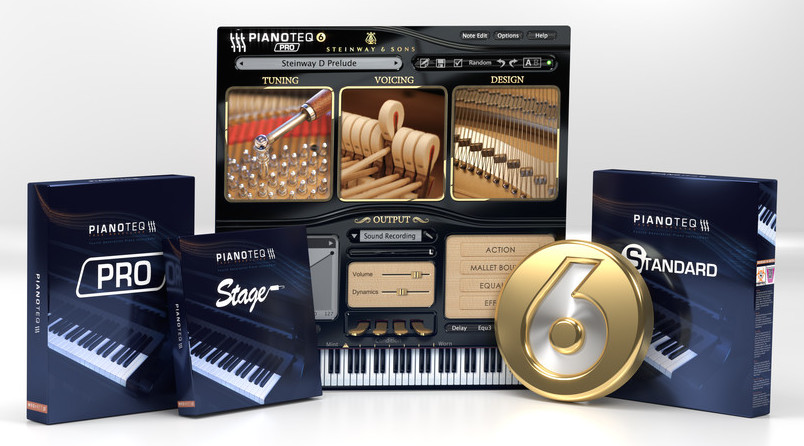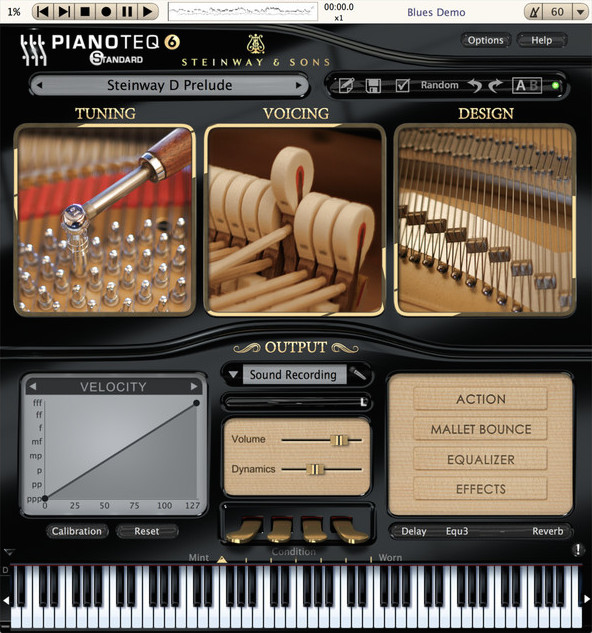New Software Review: Pianoteq 6 Physically Modeled Piano from MODARTT

With Pianoteq 6, MODARTT opts out of the massive sample library and instead relies on physical modeling, utilizing only 50MB of space—does it stack up?
One of the most common instruments in popular music—from Bach to Adele, or Bill Evans to Billy Joel—has been the piano.
If you’re a producer, it is very likely that you have at least one piano plugin—even if you never intended to, as so many DAWs offer a sampled grand piano as part of the package. Still, that free already-included piano might not fit your aesthetic. Or maybe it’s a big, multi-sampled instrument file that can be quite taxing on your computer’s resources.
Enter Pianoteq 6 by MODARTT, one of the most popular piano VST/AU plugins that is based around physical modeling rather than traditional sampling. This means that the sound of the plugin is computed via a detailed physical model involving the hammers, the strings, and the soundboard.
The lack of samples in these physically-modeled instruments means that all of Pianoteq 6 will only take up about 50MB of space! That’s a lot smaller than many of the leading virtual pianos available, for example, the 3.6GB Native Instruments Grandeur Piano, as well as most Kontakt pianos.
Today, we are going to test Pianoteq 6 and see if it can stand out in a very saturated market of virtual piano plugins.
Features
Before we get into all the features offered in Pianoteq, I want to take a second to highlight the 4 different versions of the software. There is Pianoteq 6 Stage ($129), Standard ($319), Pro ($519), and Studio ($899). Each version comes with 14 free instruments, including grand pianos, a cimbalom, harpsichords, and church bells.
Additionally, each Pianoteq version includes 2 packs of instruments from the following categories: Acoustic, Electric, and Chromatic. There are a total of 49 different packs that cover everything from electric pianos, to officially-endorsed Steinway grand pianos, to marimbas—and each additional pack only costs $59.
So what’s the difference between each version of Pianoteq? The capability to tweak.
The cheapest version, Stage, won’t allow you to edit the piano model or microphone settings, but the Standard version adds these features. Pro adds per-note editing and support for up to 192kHz audio, and the most expensive Studio version gives you access to all of the 49 sound packs. Most users might find they don’t need all the fancy options the Pro and Studio versions have to offer, which makes the Stage version seems like great value. This would be my recommendation for those just getting started with Pianoteq.
In order to cover all available features in Pianoteq, MODARTT has provided me with the Studio bundle, though it’s easy to enjoy Pianoteq’s lower-tier versions just the same.
In the main window of the GUI, you can adjust Tuning, Action, Mallet Bounce, EQ and Effects. Each of these editable sections can give some character to whichever piano you are working with. The effects include Tremolo, Wah, Chorus, Flanger, Phaser, Fuzz, Delay, Amp, Compressor, and a Mini-EQ. Further parameters available include Octave Stretching (slightly sharpening the higher octaves and flattening the lower ones), Hammer Hardness, String Length, and Sympathetic Resonance.
I found that I love adjusting the Unison Width (the detuning of each of the three strings per note) to add a natural chorus/out-of-tune piano sound, which I find is effective in mimicking the player piano sounds used by Ramin Djawadi for the music of Westworld.
The ability to calibrate keyboard response in Pianoteq is also a very nice touch, and you can even save velocity response presets for each of your keyboards so that they interact naturally with the software. The standalone version of Pianoteq also comes with a MIDI Archiver, so that if you are playing and come up with a cool idea for a song, but forgot to record it, you can retrieve a retroactive MIDI recording of the performance to import into your DAW of choice.
Additionally, you can import your own impulse responses directly into Pianoteq, and I’ve greatly enjoyed running my custom Bricasti presets into the software.
In Use
Sound-wise, the Concert Harp, Steel Pans, Xylo, and Vibes feel incredibly dynamic and musical. When scripting sampled instruments, it’s common to use round robins (multiple samples of the same note played at the same velocity to add variation every time you hit that key at that velocity)… but these Pianoteq instruments seem to have that natural variation already built in. Though subtle, this kind of variation goes a long way in making these packs feel like “real” instruments.

A closer look at Pianoteq 6’s GUI reveals the deep levels of customization available in this unique, physically-modeled virtual instrument.
Having grown up on a Steinway 1098 and generally gravitating towards Model D’s in recording studios, I was very excited to play the Pianoteq 6 Model D pack. The sound quality was astonishing, and with my Westone IEM’s in, I felt like I was in a room with that piano.
The Condition slider on the bottom of the GUI allows you to go from Mint to Worn, and I love the slight tuning inconsistencies introduced by moving towards the Worn side. This added another level of realism and excitement to performing with Pianoteq. I was also surprised that I ended up liking the sound of the Model B pack slightly more, as it was a bit lighter and warmer.
One of my favorite Kontakt pianos is the Una Corda felt instrument that Native Instruments designed with Nils Frahm. I was sad to see there was no felt piano preset in Pianoteq, but I found it was easy to make one by adjusting the hammer softness parameter, which gave a very light touch with some of the upright pianos in the collection.
To Be Critical
There is almost too much potential for tweaking in Pianoteq 6, but I don’t know if that’s necessarily a bad thing. Pianoteq is slowly becoming one of my favorite piano libraries (especially for pop music), but there is one small thing that it lacks compared to some of my favorite piano sample libraries:
Una Corda, which I mentioned earlier, captures Nils Frahm playing each key on a felt piano; Hans Zimmer Piano by Spitfire captures the grandeur of a great-sounding Steinway in the world-renowned AIR Studios in London; Native Instruments’ Alicia’s Keys features the legendary piano that has been used on many hits. In direct comparison to these libraries, there’s a certain authenticity that is lacking in Pianoteq.
I’m sure with enough tweaking, one could make a Pianoteq preset that sounds somewhat close to Alicia Keys’ piano. But there’s something refreshing about sample-based piano software and its ability to capture a legendary instrument—sometimes played by a world-renowned musician—in a great sounding room.
When writing this review, I made sure to also listen to a concert grand comparison video on YouTube for reference. I will say that some of the sounds—especially with their default presets—sounded a tad plasticky to me at first. This may be because a lot of the stock presets are pretty dry. I realized that in some ways, Pianoteq can sound like a piano in a small living room (generally not the sound I’m after), but by adding some reverb to the starting presets, it instantly became more lively and inspiring to play.
To be fair, and to contradict my own criticism, I had felt similarly when the Kemper Profiling Amp first came out. I thought “This sounds close, but it will never capture the essence of Dave Friedman or Jose at Marshall using amps with real, warm tubes and capacitors.” Lo and behold, a few years later I sold most of my tube amps and replaced them with digital guitar processors.
Summing it Up
Pianoteq 6 is a grandiose collection of physically-modeled virtual instruments that are all very musical and inspiring. And the fact that it’s only a 50MB download means it can fit on most hard drives. For this reason alone, Pianoteq will be my go-to piano for sketches, and will surely remain the final piano I use in many of my productions. Not to mention, the marimbas, glockenspiels, harpsichord, and electric pianos also all sound incredible!
Pianoteq will also surely improve with each further update, and though I don’t think it will replace my favorite sample libraries, it will surely be a great addition to my digital toolkit of differing pianos. It’s also worth noting that Pianoteq 6 has had great improvements in efficiency since its last iteration, and is not too heavy on your computer’s resources.
If you want all of the sound packs Pianoteq has to offer, the $899 price tag for the full Studio bundle is quite pricey, especially compared to Spectrasonics’ Keyscape, Native Instruments’ Komplete, and Arturia’s physically-modeled Piano V2. However, Pianoteq is still cheaper than a lot of the top sound modules from keyboard companies, and the 3 lower-tier versions most definitely hold their own. Whether you’re an A-list producer or a hobbyist, there is a version of Pianoteq for everyone!
Please note: When you buy products through links on this page, we may earn an affiliate commission.






